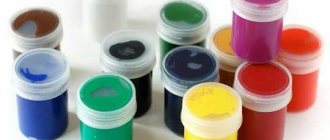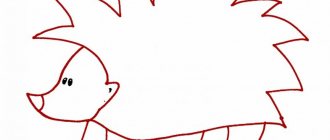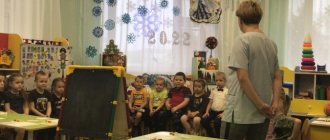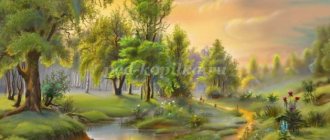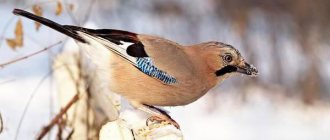GCD summary. Modeling “Hedgehog” in the senior group of preschool educational institutions
The plan is a summary of the GCD in the senior compensation group. Topic: “Hedgehog” (plasticine modeling)
Author: Tsutserova Natalya Alexandrovna.
My work may be useful for kindergarten teachers and additional education teachers. Integration of educational areas : cognitive, speech, communication, artistic - aesthetic, physical. Goal: teach children to sculpt wild animals. Objectives: Cognitive development: • Develop interest in wild animals. • Expand knowledge about hedgehogs: appearance, lifestyle, nutrition. • Learn to understand the relationships in nature. • Respect for nature. Social and communicative development: • Clarify knowledge about the rules of behavior in nature. • Develop independence when performing work. • Develop the ability to work together with peers. Speech development: • Develop the ability to perceive fiction. • Develop sound and phonemic hearing. • Develop connected, interactive speech. • Develop the ability to answer questions with complete answers. • Practice onomatopoeia. Artistic and aesthetic development: • Teach children to sculpt a hedgehog, conveying the characteristic features of its appearance, and complement the image. • Develop an interest in working with plasticine. • Develop an aesthetic attitude towards the surrounding world. • Develop fantasy and imagination. Physical development • Develop fine motor skills of the hands. • Prevent children from becoming tired. Methods and techniques. • Gaming: didactic, verbal games.
• Practical: examining a sample, doing the work independently. • Visual: showing and explaining the work • Verbal: situational conversation, questions, explanations from the teacher. Materials: plasticine (beige, brown, gray), napkins, seeds. Progress of the lesson.
- Guys, let's play!
The game is called "Football". Children throw a ball to each other and name forest animals. Surprise moment: - Look, guys, someone brought a basket. I wonder what's there? (teacher raises handkerchief) - Note! (Reading) Angry touchy lives in the wilderness of the forest There are a lot of needles, But not one thread. (Hedgehog)
- Right. Look what a beautiful hedgehog! “Once, a hedgehog I knew told me the following story. When he was very small, he had blind eyes, deaf ears, and no needles at all. The hedgehog's mother would not let him go far from her until good, strong needles appeared. The hedgehog has a lot of needles, which are renewed every 3 years. He has 36 teeth. When hunting, he relies only on hearing and smell, as his eyesight is very poor. — What do you think hedgehogs eat? — Hedgehogs feed on insects, small birds, bird eggs, lizards, berries, snakes, frogs. — Do hedgehogs have enemies? — Of course, there are eagle owls, large owls, hawks, and foxes. — What do hedgehogs need needles for? - Yes, guys, hedgehogs need needles for protection. The hedgehog is capable of curling up into a tight ball, with its spines exposed; it hisses and twitches strongly, jumping up if you touch it. -Let's try to become hedgehogs. Breathing improvisation “Hedgehog” - The hedgehog wrinkles his nose, bites his lower lip, and pronounces the sound “fff”. — The hedgehog wrinkles his eyebrows and pronounces the sound combination “puff-puff-puff.” - The hedgehog puffs out his cheeks, then exhales with the sound “pu-u-u” - The hedgehog is tired, exhale through his throat with the sound “ha-a-a” Well done! - Guys, the hedgehog hunts in the summer and breeds offspring. What does he do in winter? - Yes. The hedgehog hibernates. Hibernation lasts 128 days. When he wakes up, the hedgehog is very hungry, so he spends several days searching for food. — How to understand the proverb: “The hedgehog is the nurse of the forest and the ship of the edges.” - Ri. The poem “He’s like a Christmas tree” He’s like a Christmas tree, Covered in needles, Bravely catching scary snakes. And although he is very prickly, don’t you dare offend him. He lives in the forest. But the funny hedgehog also enters the gardens. — Hedgehogs live in the forest. Even in our forests of the Samara region. -Why can’t you take a hedgehog home? - Yes you are right. It really shouldn't be taken home as it is a wild animal and should live in the forest. Hedgehogs are also nocturnal animals. If you take him home, he simply won’t let you rest at night, as he stomps so much. And at home he can die. — If you can’t take a hedgehog home, what can you do? -Made from plasticine. - First, we need to stretch our fingers. Physical education Hedgehog, prickly hedgehog The fingers of two hands are clasped together.
Show the needles.
Movement of the brushes to the right, left.
Here they are, here they are, here they are.
We straighten our fingers, clasp our hands.
Hedgehog, prickly hedgehog
Put them in a castle
Hide your needles. Once, and there are no needles.
Doing practical work:
1. Warm the plasticine with your palms 2. Roll out the body of the hedgehog. From one edge we make the shape of a muzzle, a sharp nose.
3. From the side of the muzzle, we begin to insert the seeds with the sharp side into the plasticine.
4. When you reach the end of the hedgehog's back. Make sure that the plasticine is not visible from behind.
5. Make eyes and nose.
Reflection. - What wonderful work you have done! - Let's look at them.
We recommend watching:
Summary of GCD in the senior group. A journey through Chukovsky's fairy tales. Notes on direct educational activities in the senior group for children with mental retardation. Notes on cognitive and research activities in the senior group. Notes on educational activities in the senior group on the topic “How to see the air.”
Similar articles:
Summary of a safety lesson in the senior group: Safety in nature
Lesson on basic safety in the senior group. Topic: Rules of conduct while walking
Life safety tasks for children 5-7 years old
Summary of a lesson on plasticineography in the middle group “Hedgehog-prickly coat”.
Summary of a lesson on plasticineography in the middle group
“Hedgehog-prickly coat”.
Target:
Teach children to convey the image of a hedgehog using plasticineography technique.
Tasks:
1. Teach children to pinch off small pieces of plasticine from the main piece and smear them in a limited space.
2. Develop fine motor skills of the hands.
3. Cultivate perseverance, a sense of beauty, and the ability to work carefully.
Material:
plasticine, napkins, silhouettes of hedgehogs according to the number of children, a basket, toys: a hedgehog, a wolf, music.
Progress of the lesson:
(We draw the children’s attention to some sounds heard in the basket.)
Educator:
Guys, listen, what are these sounds? Who came to us there? (Music sounds)
Educator:
We take it out of the basket... He lives in a dense forest, he himself is round and prickly. Guess who it is? Well, of course, this is (we show... a hedgehog.
Educator:
Yes, it's a hedgehog!
What a prickly coat he has! How many needles a hedgehog grows on its back! Touch its needles (children touch a hedgehog ).
Educator:
Touch carefully, don't get pricked! The hedgehog's needles are long and sharp! What kind of spines does a hedgehog have? What color are the needles? Do you know why a hedgehog needs a lot of needles? These hedgehog needles protect from enemies. If the wolf wants to offend him, but he will prick him with needles, the wolf will run away! Hey guys, is there anyone else in the basket? (look into the basket)
Educator:
Guys, it turns out that the hedgehog came to visit us not alone, but with his hedgehog friends. (We take out pictures.)
Educator:
Guys, look, do these hedgehogs have prickly coats? (needles grow on the back)
Children:
No
Educator:
What or how will they defend themselves from enemies? Let's help the hedgehogs and “draw” needles for them. Look at the tables, what will we use to “draw” the hedgehog’s needles?
Children:
With plasticine I invite the children to sit at the tables.
Educator:
Let's prepare our hands for “drawing”.
Finger gymnastics:
Little hedgehog is frozen
And curled up into a ball
The sun warmed the hedgehog
The hedgehog turned around
Educator:
Well done, now look at the hedgehog and show me with your finger where the hedgehog’s back is, where we will “draw” the needles. What color will we use to paint the hedgehog’s needles?
We draw the children's attention to the easel on which the teacher's hedgehog blank is attached.
Educator:
I also have a hedgehog, and together with you I will draw needles for him.
They all took a piece of black plasticine. With the other hand they plucked off a small piece of plasticine. We press it on the back of the hedgehog and smear it.
The teacher shows all his actions on an easel. During the work, the teacher provides individual assistance to children. Using the “hand in hand” technique or repeated verbal explanation.
Educator:
What wonderful hedgehogs we have turned out to be. Bring them all to me.
Conclusion.
Educator:
Along a dry forest path, feet stomping, walking, wandering along the paths, a gray hedgehog covered in needles... Children bring the hedgehogs, the teacher attaches them to the stand.
Educator:
Guys, what did we do with you?
What kind of hedgehog did you get? Children:
They drew needles for hedgehogs.
Educator:
Watch how the hedgehogs rejoice in their new spiky coats. Well done guys, you tried your best to draw. Now they are not afraid of more than one enemy. The hedgehogs are joyful, cheerful, they are happy that all the children did a good job.
Hedgehog with sunflower seeds
As you have seen from the previous instructions, sculpting a hedgehog is not that difficult. There is a slight problem with small parts, because children under five years old often cannot make them. But using seeds instead of thorns is an original solution.
As in previous master classes, we will need plasticine and a board. Sunflower seeds complement this list.
Let's look at how to make a hedgehog from plasticine and seeds:
- Knead the brown plasticine until it is completely pliable for modeling. Form a ball. We pull back the material to make the nose. The rest of the body can be left unchanged, because the hedgehog often rolls into a ball to protect itself from the enemy. Attach a small brown drop to the sharp end. Add eyes.
- Now you can do what little children love so much - attaching seeds. They need to be carefully inserted with the wide part into the body. You don't need to press hard. Start laying out the first row at the muzzle. The second row must be placed between the gaps of the first so that all the empty space is filled.
This simple plasticine modeling for children will interest your child. Offer to decorate the craft with additional elements, for example, gifts of autumn, which the child already knows how to sculpt.
modeling lesson on the theme “Hedgehog”
Program content: -Teach children to sculpt a hedgehog, conveying the characteristic features of its appearance. -Experiment with art materials to depict a hedgehog’s prickly “fur coat.” - Direct them to an independent search for means of figurative expression. -Develop a sense of form and composition ability. -Cultivate confidence and initiative in visual arts. Preliminary work.
-Presentation of a photo with the image of hedgehogs.
-Conversation about the appearance and lifestyle of hedgehogs.
-Reading the story “Hedgehog” by E. Charushin.
-Guessing riddles about forest animals.
-Reading of the poem “Hedgehog” by V. Shipunova:
The hedgehog is waiting for the bear cub, the hedgehog is gnawing on an apple. He will gnaw to the middle and leave half of the fragrant fruit for furry Mishenka. The fact is that the bear cub has been friends with the hedgehog since the cradle.
Materials, tools, equipment.
-Plasticine, for “needles”, different materials to choose from: sunflower seeds, toothpicks, matches, cocktail tubes, cut into pieces 3-5 cm long; -for the eyes and nose, material to choose from: beads, small buttons, seed beads, buckwheat grains; stacks, oilcloths, paper napkins and fabric “clearings” made of colored cardboard for stands (in the shape of irregular ovals).
Contents of the lesson.
The teacher asks the children two or three riddles about hedgehogs, for example:
Not green, but prickly - snorting at the Christmas tree!
The creeper is crawling, carrying needles, curled up into a ball - no head, no legs.
Crawling, carrying needles; As soon as anyone approaches, he curls up into a ball - no head, no legs.
Conversations about the appearance and lifestyle of hedgehogs. Presentation of a photo with the image of hedgehogs. After this, the teacher reads to the children G. Lagzdyn’s poem “The Prickly Hedgehog”: The hedgehog is prickly, But not angry! Just a hedgehog's clothes made of needles, finely sewn by masters, so that on occasion he could hide his legs and curl up into a round ball on a forest path. Here's some clothes so that they don't touch the hedgehog.
The teacher invites the children to make hedgehogs with long needles, on which they carry supplies to their holes to feed the little hedgehogs. He asks how to make needles. After the children’s answers, he shows toothpicks, matches, pieces of cocktail straws and advises using them to decorate the prickly hedgehog’s “clothes.” Then he wonders how the children will sculpt hedgehogs. Summarizes children’s suggestions and clarifies the technique of sculpting from a whole piece:
-take a lump of plasticine, roll out a ball and turn it into an egg - narrower in front, wider in back;
-we stretch out and sharpen the nose, slightly lift it up, as if a hedgehog is sniffing where the mushrooms grow;
-we decorate the hedgehog’s prickly fur coat, stick “needles” into the back, choose the material for the “needles” as you wish - sunflower seeds, toothpicks, matches, cocktail tubes, cut into pieces;
-decorate the muzzle - attach the eyes and nose; we choose the material according to our wishes - beads, beads, small buttons, buckwheat grains or small balls of plasticine;
-make mushrooms or apples and place them on the hedgehog’s back.
Children choose the color of plasticine at their request (yellow, orange, pink, gray, brown, etc.), material for “needles” (seeds, toothpicks, tubes, etc.), “clearings” made of colored cardboard for coasters and start sculpting.
At the end of the lesson, children place their hedgehogs in the “clearings” and transfer them to the general exhibition.
Used Books:
Lykova I.A. Visual activities in kindergarten: planning, lesson notes, methodological recommendations. Middle group - M.: "KARAPUZ - DIDACTICS", 2008.
“A Reader for Little Ones”, ed. L.N. Eliseeva.
How to make a hedgehog from plasticine
If your child likes to create animal figures from plasticine, invite him to make a hedgehog. This cute, prickly animal will add to your baby's collection of products. To make a little animal, we suggest you choose one of the instructions below. You will learn how to make a hedgehog from plasticine in different ways.
If you have already sculpted a cat from plasticine, which we talked about in the previous article, then making a charming hedgehog will not be difficult. We have selected several options for making a hedgehog for you. The first two will be based only on the use of plasticine.


